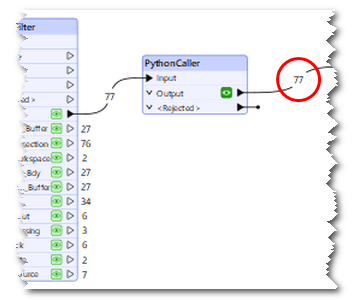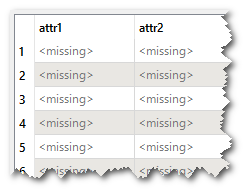
Hi, I would like some help with PythonCaller. I have a workflow where I read in feature classes from an Esri file geodatabase, combining the features into a single attribute to make it dynamic. I filter out annotation, resolve domains and rename original domain fields, map empty and missing features to Null, then use AttributeFilter to split by FME Feature Type.
My next desired steps are to identify, for each FME Feature Type, which attributes are nulls, and remove those attributes, then connect all splits to a Writer to write out to shapefiles grouped by FME Feature Type.
I am trying to use PythonCaller to remove the null attributes. It stores the attribute names in a list, and stores in a dictionary called alnum_tracker attribute names and whether they contain data (where they are saved as True), before comparing the list of attributes to the dictionary, deleting any that are not matches. I’ve tested it and it is grabbing the correct attributes to delete and keep. The Python works, and my logged messages output expected results from the data. However, when I use pyoutput to output features, I get nothing. No features get outputted. I get the messages in my Translation Log:
“Destination Feature Type Routing Correlator (RoutingFactory): Tested 77 input feature(s), wrote 77 output feature(s): 0 matched merge filters, 0 were routed to output, 77 could not be routed”
“Final Output Nuker (TeeFactory): Cloned 77 input feature(s) into 0 output feature(s)”.
I’m new to FME and using PythonCaller in FME. I want to know why I can’t get output features from PythonCaller. My workflow is shown above, and my code below.
import re
import fmeobjects
class FeatureProcessor:
def __init__(self):
self.alnum_tracker = {}
self.feature_list = []
self.pattern = re.compile(r'[a-zA-Z0-9]')
def input(self, feature):
self.feature_list.append(feature)
for attr in feature.getAllAttributeNames():
val = feature.getAttribute(attr)
if isinstance(val, str) and self.pattern.search(val):
self.alnum_tracker[attr] = True
elif isinstance(val, (int, float)) and val is not None:
self.alnum_tracker[attr] = True
def close(self):
fmeobjects.FMELogFile().logMessageString(f"Number of features collected: {len(self.feature_list)}", fmeobjects.FME_INFORM)
fmeobjects.FMELogFile().logMessageString("Alnum tracker: " + str(self.alnum_tracker), fmeobjects.FME_INFORM)
if not self.feature_list:
return
all_attrs = self.feature_list[0].getAllAttributeNames()
attrs_to_remove = [attr for attr in all_attrs if attr not in self.alnum_tracker]
fmeobjects.FMELogFile().logMessageString("Attributes to remove: " + str(attrs_to_remove), fmeobjects.FME_INFORM)
for feat in self.feature_list:
for attr in attrs_to_remove:
feat.removeAttribute(attr)
fmeobjects.FMELogFile().logMessageString("Outputting feature", fmeobjects.FME_INFORM)
fmeobjects.FMELogFile().logMessageString("Feature type: " + feat.getFeatureType(), fmeobjects.FME_INFORM)
original_type = feat.getFeatureType()
feat.setFeatureType(original_type)
fmeobjects.FMELogFile().logMessageString(f"Feature list length: {len(self.feature_list)}", fmeobjects.FME_INFORM)
protected_attrs = {"_feature_type", "fme_feature_type", "routing_key"}
attrs_to_remove = [attr for attr in all_attrs if attr not in self.alnum_tracker and attr not in protected_attrs]
self.pyoutput(feat)
fmeobjects.FMELogFile().logMessageString("Remaining attributes: " + str(feat.getAllAttributeNames()), fmeobjects.FME_INFORM)
How do I make my Python output talk to my data properly so that I get output features from it that are missing the null attributes?









